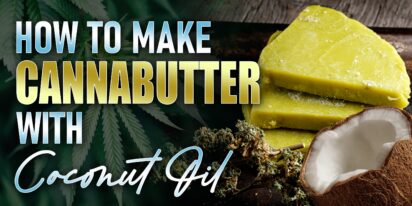
Are You 18 Or Over?
YesOr
No By clicking yes, you certify that you are over 18. By using this website, you agree to our legal disclaimer.605+ Cannabis Strains over 20 Breeders worldwide.
Table of Contents

Table of Contents
Choosing the best ingredients sets the stage for making outstanding cannabutter. When getting cannabis flowers, go for organic types that are pesticide-free and clean, guaranteeing a pure and tasty infusion. Similarly, virgin coconut oil, taken from fresh coconut meat, gives a rich and fragrant foundation for blending with cannabis, adding a hint of tropical taste to your creations. By focusing on top-notch ingredients, you can enhance the flavor and strength of your cannabutter while reducing any possible health hazards from chemical residues.
During the infusion process, the magic of cannabutter truly happens as the cannabinoids from the cannabis flower mix with the fats in coconut oil, creating a powerful and versatile ingredient. To get the best results, it’s important to grasp the main principles of decarboxylation and infusion. Decarboxylation, or “activating” the cannabinoids, means heating the cannabis flower to change non-psychoactive compounds like THCA into THC, the main psychoactive part. This step ensures that your cannabutter gives the effects you want when you eat it. Then, the infusion process involves gently simmering the decarboxylated cannabis in coconut oil over low heat, letting the cannabinoids dissolve and attach to the fats in the oil. By mastering these basic techniques, you can unlock all the power of your cannabutter, getting the best potency and flavor every time you make it.
Decarboxylation is the vital first step in activating the cannabinoids in the cannabis flower, making sure your cannabutter gives the effects you want when you eat it. To start, heat your oven to 240°F (115°C) and line a baking sheet with parchment paper. Then, roughly grind your cannabis flower using a grinder, making sure the pieces are all about the same size. Spread the ground cannabis evenly on the prepared baking sheet, making sure not to put too much or let the pieces overlap. Put the baking sheet in the preheated oven and bake for 40-60 minutes, until the cannabis turns lightly golden and smells good. During decarboxylation, the cannabis is gently heated, changing non-psychoactive compounds like THCA into THC, the main psychoactive part that gives cannabis its effects. When decarboxylation is done, take the baking sheet out of the oven and let the cannabis cool before moving on to the next step of infusion.
Now that your cannabis is decarboxylated, it’s time to turn it into cannabutter by infusing it into coconut oil. Start by melting the virgin coconut oil in a double boiler or saucepan over low heat, making sure not to let it boil or burn. Once the coconut oil is melted, add the decarboxylated cannabis to the pot, stirring gently to spread it evenly. Let the mixture simmer on low heat for 2-3 hours, stirring occasionally to keep it from sticking or burning. During this time, the cannabinoids from the cannabis will dissolve into the coconut oil, giving it their beneficial properties and unique flavor. Keep a close eye on the temperature as it simmers, adjusting if needed to keep it gently bubbling. After 2-3 hours, take the pot off the heat and let the mixture cool a bit before straining it.
After the infusion is finished, it’s time to strain the mixture to get rid of any leftover plant bits and sediment, giving you smooth and strong cannabutter. To do this, put a piece of cheesecloth over a clean container or bowl, making sure it covers the opening completely. Slowly pour the infused coconut oil through the cheesecloth, letting it strain into the container below. Use a spatula or spoon to press gently on the cheesecloth, squeezing out as much infused oil as you can while leaving behind any solids or sediment. Once it’s strained, put the cannabutter in an airtight container and store it in the fridge. If you store it right, cannabutter can stay fresh and potent for a few months, ready to use in lots of different recipes.
Getting the right dose for your cannabutter is key to getting the effects you want without having too much. Things like how strong the cannabis is, how long you infused it for, and your own tolerance all matter when figuring out the dose. Begin with a small amount of cannabutter, like a teaspoon, and wait at least two hours before having more to see how it affects you. Keep a journal to record your dose and how you feel, so you can change things up next time if needed.
Creating cannabutter at home offers the chance to play around with various flavors, tailoring your creations to match your taste buds. Coconut oil adds a gentle tropical taste to cannabutter, blending well with the earthy notes of cannabis and giving a subtle sweetness. If you want a stronger coconut flavor, think about using toasted coconut oil or adding coconut extract while infusing. Or, you can spice up your cannabutter with herbs, spices, or other flavors, letting you make special infusions that fit your cooking style perfectly.
Becoming skilled at making cannabutter coconut oil is a fulfilling venture that lets you dive into a world of culinary adventures. By following our detailed guide and expert advice, you’ll have everything you need to whip up tasty and potent cannabis-infused treats right in your own kitchen. Whether you’re a seasoned cook or just starting out, trying out cannabutter lets you delve into the connection between cannabis and cooking, adding therapeutic benefits and unique flavors to your dishes. So, gather your ingredients, get ready to cook, and set off on a culinary journey with cannabutter leading the way.
Q: Can I use trim or shake instead of cannabis flower?
A: Yes, trim or shake can be used to make cannabutter, but keep in mind that potency may vary compared to using flower buds.
Q: How long does infused coconut oil last?
A: When stored properly in an airtight container in the refrigerator, infused coconut oil can last for several months.
Q: Can I use cannabutter in savory dishes?
A: Absolutely! Cannabutter adds a unique flavor and potency to a variety of savory recipes, including pasta sauces, sautés, and marinades.
Q: Can I freeze cannabutter for long-term storage?
A: Yes, freezing cannabutter is an excellent way to extend its shelf life. Simply portion it into individual servings and store in an airtight container in the freezer.
Q: How do I calculate the potency of my cannabutter?
A: To determine the potency of your cannabutter, consider factors such as the THC percentage of your cannabis, the amount used in the recipe, and the serving size.
Q: Can I use store-bought coconut oil for making cannabutter?
A: While store-bought coconut oil can be used, opting for virgin coconut oil ensures a purer flavor and higher quality infusion.

In recent years, the discourse surrounding secondhand marijuana smoke has gained significant attention, paralleling the legalization and increas

In the realm of cannabis culture, the practice of "wake and bake" holds a significant place, accompanied by both supporters and skeptics. As exp

Introducing the robust indica strain known as Critical Mass weed, a harmonious fusion of Afghani and Skunk #1 genetics. Delve into its essence,

Fusarium wilt cannabis represents a significant threat to cannabis cultivation, necessitating a comprehensive understanding of its intricacies.

1980s were a time of profound cultural transformation, marked by iconic fashion, music, and movies. Alongside these trends, a unique facet of '8

[ez-toc] In the deep history of cannabis cultivation, there exists a captivating and creative practice that combines the art of cultivation wit

For growers looking to get better yields and healthier cannabis plants, it's important to understand and control the cannabis soil pH levels. pH

[ez-toc] In indoor gardening, maintaining an optimal temperature within your grow tent is crucial for the health and productivity of your plant

[ez-toc] Welcome to the delightful world of cannafudge crafting, where sweetness meets sophistication, and cannabis infusion adds a unique twis

[ez-toc] You’ve finished trimming your weed, but what about those leftover stems? Don’t throw them away! These seemingly useless bits can a

Are You 18 Or Over?
YesOr
No By clicking yes, you certify that you are over 18. By using this website, you agree to our legal disclaimer.